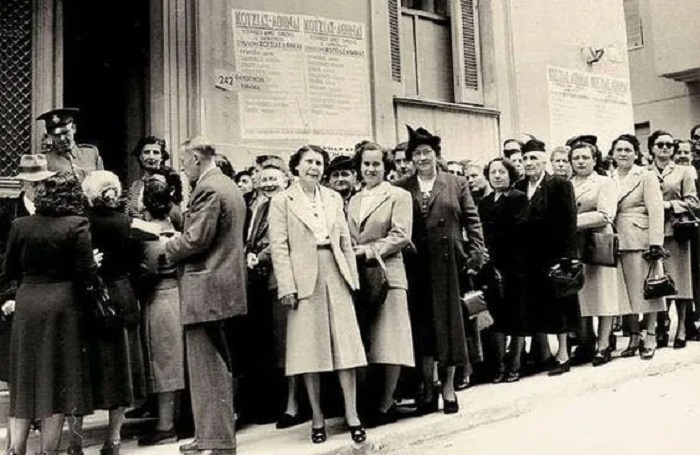
The history of elections in modern Greece began in 1833, with the first King of Greece, Otto of Bavaria, introducing the paper ballot. The occasion was the municipal elections for the Argolis-Corinth prefecture in July of 1834.
The concept of a modern plebiscite was something new for the Greek people, who had won their independence just a few years earlier, after almost 400 years of Ottoman rule.
The second vote was held in 1844, this time for parliamentary elections after the September 3rd, 1843 revolt.
Of course, the concept of voting itself has a much longer history, going back to ancient Greece and the democracy of Athens and other city-states. The Greek word for ballot is ψήφος (psifos), which means a small, polished stone. Voters used white stones if they agreed with the candidate or issue, and black stones if they disagreed.
In the July, 1834 election in Argolis-Corinth, voters were given a white piece of paper on which they wrote the name of the candidate of their choice. However, the handwritten ballot was later abolished by the 1864 Constitution, because the majority of Greeks were illiterate at the time, and they could therefore be easily manipulated by candidates.
To replace the paper ballot, small round lead pellets were introduced after an idea proffered by lawmakers from the Ionian Islands. The suggestion was made on the grounds that this was the type of ballot used in developed European countries at the time.
The lead pellet ballot was still being used in the Ionian Islands at the time, a remnant of centuries of Venetian rule. The establishment of the pellet ballot was intended to ensure voting secrecy after the experience of the ill-fated election during the Ottoman period, in which paper ballots were used.

The first national election using round pellet ballots, which was won by Alexandros Koumoundouros, took place in May of 1865.
The procedure was as follows: in each polling station there were as many ballot boxes as there were candidates. The tin ballot box for each candidate was divided into two parts: The right part was white, with the word YES written on it; the left was black for NO. An angled tube was fastened to the ballot box, which conducted the pellets to the corresponding side of the box.
Voters would take a lead pellet from a large bowl and lift their hand with it, showing the electoral committee that they were holding only one pellet, or vote. They would then approach the ballot box and drop the round pellet into the partition which corresponded to “YES” or “NO”. The “YES” corresponded to a positive vote and “NO” to disagreement.
This meant that a voter who desired to vote against a candidate would drop their ball into the black-colored section of the ballot box, which led to the expression “blackened.”
Fanatical supporters of a candidate would sometimes even bite their lead ballot pellet, leaving their teeth marks on the surface to show their dedication to their favorite man. Hence the expression “I cast my bitten ballot”, or just the plain term “bitten.”
Each voter had to go through all the candidates’ ballot boxes and follow the same procedure for each one. If he failed, he was fined and sentenced to imprisonment. It is clear that the voting procedure was extremely time-consuming for the voter.
Unfortunately, the pellet ballot did not eliminate fraud. Cunning candidates and their supporters were somehow always able to invent ways to distort the electoral outcome. However, this type of malfeasance was significantly reduced after the criminal provisions of the electoral law of 1877.
The main trick in falsifying the ballot was the physical overturning of ballot boxes. The pellets would then become mixed and therefore would be uncountable. However, the lead ball, coupled with the universal right to vote, had already made Greece a pioneer in direct elections on a European scale.
Things had started to change dramatically by the twentieth century, as Greece was developing economically and illiteracy had dropped to 50 percent. The pellet ballot was then considered obsolete and the request for a paper ballot came to the forefront.
Addressing the House in 1910, Alexandros Papanastasiou stressed that the paper ballot safeguarded voting procedures and limited falsified results, as court officials would supervise voting procedures and, more importantly, be present during the counting of ballots.
There was no article regarding the round pellet ballot in the 1911 Constitution, which bore the authoritative seal of Eleftherios Venizelos; therefore, it was left to the legislature to declare by law all voting mechanisms and procedures.
The paper ballot returned in the municipal and local government elections of 1914 and the parliamentary elections of November 7, 1926, along with the making of an X next to a candidate’s name, a process which is still in existence today.

Women in Greece win the right to vote in elections
On May 28, 1952, the Greek Parliament passed “Law 2159,” finally giving all Greek women the right to vote in national elections, despite widespread adverse reactions from conservatives. Since 1930, only educated women over 30 years of age had been able to vote — but even then, only in municipal elections.
Women could not vote in the November 1952 national elections, however, since there hadn’t been enough time for all of them to be included on the electoral registers. So the first time Greek women actually cast their ballots in national elections was on February 19, 1956.
The first woman elected to the Greek Parliament was Eleni Skoura, a representative from the Thessaloniki Prefecture, in the elections of January 18, 1953.
See all the latest news from Greece and the world at Greekreporter.com. Contact our newsroom to report an update or send your story, photos and videos. Follow GR on Google News and subscribe here to our daily email!



